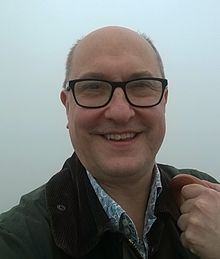Children one sone d Name Roger Highfield | Role Author | |
 | ||
Institutions Science Museum GroupNew ScientistDaily Telegraph Alma mater Christ's HospitalUniversity of Oxford (MA, PhD) Spouse Julia Brookes (m. 1992) Books Super Cooperators: Beyond t, The Science of Harry Pott, The Physics of Christma, The private lives of Albert Ein, Can Reindeer Fly?: The | ||
Roger highfield we re all born scientists
Roger Ronald Highfield (born 1958 in Griffithstown, Wales) is an author, science journalist, broadcaster and director of external affairs at the Science Museum Group.
Contents
- Roger highfield we re all born scientists
- Roger Highfield on his book SuperCooperators written with Martin Nowak of Harvard University
- Education
- Career
- Popular science books published
- The Mind Readers
- Supercooperators
- After Dolly
- The Science of Harry Potter
- The Physics of Christmas
- Frontiers of Complexity
- The Private Lives of Albert Einstein
- The Arrow of Time
- Awards and honours
- Personal life
- References
Roger Highfield, on his book SuperCooperators (written with Martin Nowak of Harvard University)
Education
Highfield was educated at Chase Side Primary School in Enfield and Christ's Hospital in Horsham. He read Chemistry at Pembroke College, Oxford and was awarded a Master of Arts degree in Chemistry in 1980 followed by a Doctor of Philosophy for research on Neutron scattering from chemical species.
During his research career, he was the first to bounce a neutron off a soap bubble while he was working at the Institut Laue Langevin.
Career
Highfield was the Science editor of British newspaper The Daily Telegraph for more than 20 years. During that time he set up a long running science writing award for young people, a photography competition, the 'scientists meet the media' party, and organised mass experiments from 1994 with BBC's Tomorrow's World, called Live Lab and Megalab, such as the 'Truth Test' with Richard Wiseman.
He was the editor of the British magazine New Scientist from 2008 to 2011, where he redesigned the magazine and introduced new sections, notably Aperture and Instant Expert.
As of 2011 Highfield became the Director of External Affairs at the Science Museum Group.
In 2012, he published the results of a mass intelligence test with Adrian Owen.
In 2016 he launched a critique of Big Data in biology with Ed Dougherty of Texas A&M and Peter Coveney.
Popular science books published
Highfield has written or co-authored seven popular science books, and edited two written by Craig Venter, including:
The Mind Readers
In 2014 he wrote a 10,000 word article The Mind Readers in Mosaic, published by the Wellcome Trust. His account of the efforts to communicate with brain damaged patients that suffer disorders of consciousness was reproduced in other media worldwide, such as Gizmodo, The Week, The Independent and Pacific Standard.
Supercooperators
In 2011 his book Supercooperators: The Mathematics of Evolution, Altruism and Human Behaviour (Or, Why We Need Each Other to Succeed) was published, co-authored with Martin Nowak. A review published in Nature by Manfred Milinski describes the book as "part autobiography, part textbook, and reads like a best-selling novel." David Willetts, in the Financial Times, described the book as an "excellent example" of using the nexus of evolutionary biology, game theory and neuroscience to understand the development of cooperation in society
After Dolly
In 2006 his book After Dolly: The Uses and Misuses of Human Cloning was published, co-authored with Ian Wilmut. Steven Poole in The Guardian describes the book as "an extremely lucid and readable explanation of the history of cloning and biologists' ideas for the future."
The Science of Harry Potter
In 2002 his book The Science of Harry Potter: How Magic Really Works was published. Christine Kenneally in The New York Times describes the book as "an enjoyably indirect survey of modern science."
The Physics of Christmas
In 1998 his book The Physics of Christmas: from the aerodynamics of reindeer to the thermodynamics of turkey was published. The British edition, Can Reindeer Fly?, got the world's shortest book review ('No')
Frontiers of Complexity
In 1996 his book Frontiers of Complexity: the search for order in a chaotic world was published, co-authored with Peter Coveney. The Nobel Laureate Philip Warren Anderson commented that 'I believe firmly, with Coveney and Highfield, that complexity is the scientific frontier.'
The Private Lives of Albert Einstein
In 1993 his book The Private Lives of Albert Einstein was published, co-authored with Paul Carter.
The Arrow of Time
In 1991 his book The Arrow of Time was published, co-authored with Peter Coveney, which became a Sunday Times top ten bestseller and New York Times notable book of the year.
Awards and honours
In 2014, he gave the Douglas Adams Memorial Lecture for Save the Rhino with Simon Singh.
Highfield is a member of the Longitude Committee, for the Longitude Prize 2014,
Highfield wrote for a time for Newsweek. and continues to write for The Daily Telegraph and The Evening Standard
After testing a treadmill desk in 2006, Highfield uses one at work in the Science Museum and has advocated their widespread adoption. He often invites his visitors to take it for a spin, including Heston Blumenthal, Craig Venter, Samira Ahmed, Al Jean, Ben Miller and Dame Gail Rebuck
He has been listed on the Evening Standard Progress 1000 in 2012 and 2016.
In 2012, Highfield gave the Wilkins-Bernal-Medawar Lecture, on Heroes of Science, at the Royal Society.
Personal life
Highfield married Julia Brookes in 1992 and has one son and one daughter.
